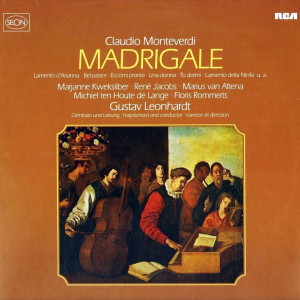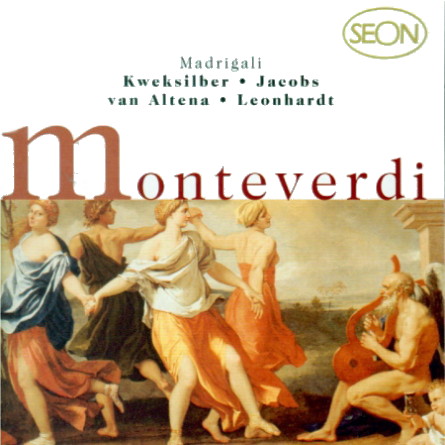 |
1 LP -
RL 30390 - (p) 1980
|
 |
| 1 CD -
SBK 60707 - (c) 1998 |
|
MADRIGALE
|
|
|
|
|
|
|
|
| Claudio MONTEVERDI (1567-1643) |
Lamento
d'Arianna - (Libro 6) |
|
12' 57" |
|
|
-
Lasciatemi morire (Prima parte)
|
1' 46" |
|
A1 |
|
- O
Teseo, o Teseo mio (Seconda parte) |
4' 58" |
|
A2 |
|
-
Dove, dov'è la fede (Terza parte) |
2' 51" |
|
A3 |
|
- Ahi, che non pur rispondi!
(Quarta e ultima parte) |
3' 22" |
|
A4 |
|
Marjanne Kweksilber, René
Jacobs, Marius van Altena, Michiel ten
Houte de Lange, Floris Rommerts
|
|
|
|
|
Alcun
non mi consigli - (Libro 9) - a 3
voci: Alto, tenore e basso
|
|
3' 05" |
A5 |
|
René Jacobs, Michiel ten Houte
de Lange, Floris Rommerts |
|
|
|
|
Lamento
della Ninfa - (Libro 8) |
|
5' 52" |
|
|
- Non
havea Febo ancora - a 3 voci: 2 tenori,
basso |
1' 30" |
|
A6 |
|
-
Amor (Lamento della Ninfa) - a 4 voci:
Canto, 2 tenori, basso |
3' 42" |
|
A7 |
|
- Si
tra sdegnosi pianti - a 3: 2 tenori, basso |
0' 40" |
|
A8 |
|
Marjanne Kweksilber, Marius van
Altena, Michiel ten Houte de Lange,
Floris Rommerts |
|
|
|
|
Bel
pastor - (Libro 9) - a 2 voci |
|
3' 47" |
B1 |
|
Marjanne Kweksilber, Marius van
Altena |
|
|
|
|
Ardo
e scoprir - (Libro 8) - a 2 tenori |
|
3' 20" |
B2 |
|
Marius van Altena, Michiel ten
Houte de Lange |
|
|
|
|
Ohimè,
ch'io cado - per voce sola (Alto) -
from "Quarto Scherzo delle ariose... di
Carlo Milanuzzi" (1624) |
|
4' 15" |
B3 |
|
René Jacobs |
|
|
|
|
Eri
già tutta mia - a 1 voce - from
"Scherzi Musicali..." (1632) |
|
2' 48" |
B4 |
|
René Jacobs |
|
|
|
|
Eccomi
pronta ai baci - (Libro 7) - a 3
voci: 2 tenori e basso |
|
1' 58" |
B5 |
|
Marius van Altena, Michiel ten
Houte de Lange, Floris Rommerts |
|
|
|
|
Una
donna fra l'altre - (Libro 6) -
Concertato nel Clavicimbalo |
|
2' 53" |
B6 |
|
Marjanne Kweksilber, René
Jacobs, Marius van Altena, Michiel ten
Houte de Lange, Floris Rommerts |
|
|
|
|
Tu
dormi - (Libro 7) - a a voci |
|
3' 01" |
B7 |
|
Marjanne Kweksilber, Marius van
Altena, Michiel ten Houte de Lange,
Floris Rommerts |
|
|
|
|
|
|
|
|
Marianne
Kweksilber, Sopran
|
|
| René Jacobs,
Alt (Countertenor) |
|
| Marius van
Altena, Tenor |
|
| Michiel ten
Houte de Lange, Tenor |
|
| Floris
Rommerts, Bass |
|
| Gustav
Leonhardt, Harpsichord
(Martin Skowroneck, Bremen, 1960, Italian
type) | Conductor |
|
|
|
|
|
Luogo
e data di registrazione |
|
Lutherse Kerk,
Haarlem (Holland) - Settembre 1979
|
|
|
Registrazione: live
/ studio |
|
studio |
|
|
Producer /
Recording Supervisor |
|
Wolf Erichson
|
|
|
Recording Engineer
|
|
Teije ven Geest
|
|
|
Prima Edizione LP |
|
Seon (RCA Res Seal) |
RL 30390 | 1 LP - durata 45' 22" |
(p) 1980 | ANA
|
|
|
Edizione CD |
|
Sony | SBK 60707 | 1
CD - durata 45' 22 - 45' 22" | (c)
1998 | ADD
|
|
|
Original Cover
|
|
Aniello Falcone
(1600-1665) - Music played at
social gatherings
|
|
|
Note |
|
- |
|
|
|
|
Monteverdi's
Sixth to Ninth Books of
Madrigals contain the
musical harvest of about
three decades of madrigal
writing. Very few of the
madrigals, however, resemble
the commonly accepted idea
of what constitutes a vocal
work so designated. Even in
the Fifth Book the first
signs of change are
noticeable: the Renaissance
type of madrigal gradually
develops into a more
sophisticated,
emotionally-laden work of
art, musically underlining
the meaning of individual
words and employing
obbligato instrumental
forces and a continuo bass -
the dawn of the Baroque.
Nevertheless, even inonody
could not put the old
madrigal style completely
off course. On the contrary,
it would seem that
Monteverdi was at times
actually encouraging the
parallel use of the two
styles.
The “Lamento d’Arianna” is
the sole surviving piece
from Monteverdi’s opera
“Arianna”. The lament of
Ariadne cruelly deserted by
Theseus, it was regarded by
Monteverdi himself as “La
più essential parte
dell’Opera”. At the première
of the opera at Mantua on
May 28th, 1608, the audience
in the great hall of the
“Invaghiti” were literally
moved to tears, and,
according to a contemporary
account, there was hardly a
household possessing a
harpsichord or lute where
the strains of this air
could not be heard forever
afterwards. In the Sixth
Book of Madrigals we find a
madrigal setting of this
tragic solo scene in which
Ariadne pours forth her
sorrow, expressing her
passionate longing, her
bitter disappointment and
her boundless love for
Theseus with gripping
intensity. Two years before
his death, in 1641,
Monteverdi wrote yet another
version of this famous
piece, this time using it in
a religious context, turning
it into a “Pianto della
Madonna” (Lament of the
Virgin) for
his collection “Selva morale
e spirituale”. The madrigal
“Una donna fra l’altre”
(Concertato nel
Clavicimbalo) must have been
written by the year 1609, as
a sacred version of the
piece appeared in that year.
Although the piece is scored
for five voices the writing
is seldom really
contrapuntal; monodic
episodes are already
becoming a dominant feature.
The madrigal “Tu dormi? Ah
crudo core” for four voices
and continuo is a setting of
a text by Giovanni Battista
Guarini, the author of the
fashionable pastoral comedy
“Il pastor fido”. The piece
opens with only three of the
voices, the bass finally
entering with a chromatic
phrase on the words “Io
piango”. Monteverdi scored
Giambattista Marini’s
verses, about the give-away
marks that too much
passionate kissing leaves
behind, for two tenors, bass
and continuo.
Although the sentiments are
obviously supposed to come
from the lips of some
amorous young maiden,
Monteverdi perhaps thought
it was too unseemly for
female voices to sing.
Concrete directions as to
the placing of the singers
for the performance of the
“Lamento della Ninfa” (“Non
havea Febo ancora”) indicate
that Monteverdi intended a
scenic presentation of this
particular madrigal. The
actual Lamento, in the words
of Hans Ferdinand Redlich a
piece “in the most delicate
of pastels”, is framed by a
narration sung by three
men’s voices, describing the
nymph distractedly rushing
from her house at daybreak.
In the manner of a Greek
chorus the men’s voices
assume the role of a
sympathetic commentator. The
Lamento is written over a
ground bass.
In the madrigal “Alcun non
mi consigli” the jilted
lover declares that he does
not wish to anger his fair,
cruel lady. The tenor, alto
and bass are each entrusted
with a recitative-like solo
passage over the same bass.
At the last line of each of
these three verses all three
voices join forces to sing a
canzonetta-like refrain.
The text of “Bel pastor”, a
dialogue between a shepherd
and a shephercless, is again
by Ottavio Rinuccini. It is
not unlikely that this
little seduction scene is an
extract from one of
Monteverdi’s lost pastoral
operas.
By contrast the opening of
the chamber-duet “Ardo e
scopir”, a musical portrait
of a helplessly shy youth,
is a perfect example of the
‘stile concitato’. The
pitiable state of the
tongue-tied young wooer at
the end of the piece goes
right to the heart -
Monteverdi achieves here a
perfect symbiosis of words
and music.
Monteverdis “aria” “Ohimè
ch’io cado” exerted a
tremendous influence on his
contemporaries. This
remarkable piece, a series
of strophic variations over
a sustained bass, appeared
in the appendix to a
publication (1624) of Carlo
Milanuzzi’s, another Italian
composer. The “aria” “Eri
già tutta mia” is taken from
the collection “Scherzi
musicali” published in 1632.
Hans
Christoph Worbs
English
translation by Avril
Watts
|
  |
|
|